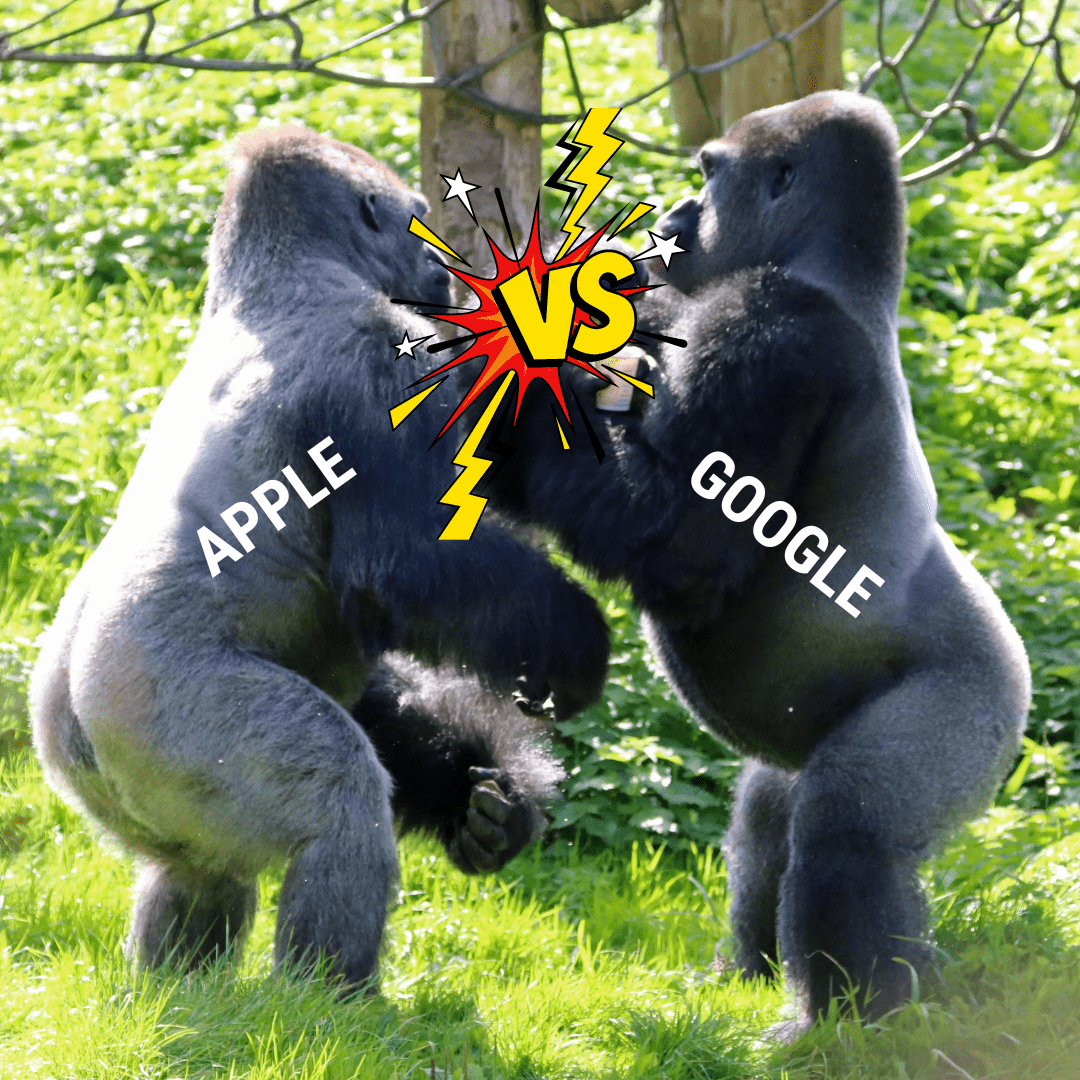The Complex Interplay Between Apple And Google's Business Models

Table of Contents
Apple and Google. Two tech giants, seemingly polar opposites, yet inextricably linked in a complex dance of competition and cooperation. Understanding their intertwined business models is crucial to grasping the dynamics of the modern tech landscape. This article delves into the key aspects of this fascinating relationship, exploring the nuances of Apple and Google business models and their impact on the tech world.
<h2>Divergent Approaches to Hardware and Software</h2>
Apple and Google employ drastically different strategies in their approach to hardware and software, shaping their respective market positions and competitive advantages.
<h3>Apple's Integrated Ecosystem</h3>
Apple's business model centers on a tightly integrated ecosystem of premium hardware and proprietary software. This strategy fosters a strong emphasis on user experience and cultivates significant brand loyalty. High profit margins are realized through hardware sales, particularly iPhones, while services revenue, encompassing offerings like iCloud and Apple Music, is increasingly crucial to their overall financial success.
- Hardware: iPhone, iPad, Mac, Apple Watch, AirPods
- Software: iOS, macOS, watchOS, iPadOS, tvOS
- Services: App Store revenue, iCloud subscription, Apple Music, Apple TV+, Apple Arcade
- Key Strategy: Creating a seamless and user-friendly experience across all devices and services.
<h3>Google's Open-Source Strategy</h3>
In contrast, Google's business model is primarily software and services-driven. Their open-source Android operating system, while generating less direct revenue than Apple's iOS, fuels widespread adoption across a vast range of devices. This broad reach allows Google to dominate in advertising and cloud services, which are the core drivers of their revenue. Google’s hardware ventures, such as Pixel phones and Nest devices, serve as complementary components to support their larger software and services ecosystem.
- Software: Android OS, Google Search, Google Chrome, Gmail
- Services: Google Ads, Google Cloud Platform (GCP), YouTube, Google Workspace
- Hardware: Pixel smartphones, Nest smart home devices, Google Chromecast
- Key Strategy: Leveraging open-source software and vast data to dominate advertising and cloud services.
<h2>The Battle for Mobile Dominance</h2>
The mobile market represents a key battleground for Apple and Google, showcasing their contrasting approaches to market penetration and user engagement.
<h3>iOS vs. Android: A Tale of Two Operating Systems</h3>
Apple's iOS boasts a higher average revenue per user (ARPU) due to its premium pricing and focus on a high-end user experience. Android, on the other hand, enjoys significantly greater market share globally due to its open-source nature and compatibility with a wide range of devices, from budget-friendly options to high-end flagships.
- Market Share: iOS holds a larger share in the high-value segment while Android dominates overall market share.
- App Store Economics: Apple's 30% cut on App Store transactions is a significant revenue stream, while Google Play's approach is slightly less lucrative for developers.
- User Experience: iOS is known for its simplicity and ease of use, while Android offers greater customization options.
<h3>The Impact on Developers</h3>
The differences between iOS and Android present both challenges and opportunities for app developers. Reaching users on both platforms requires strategies tailored to each operating system's unique characteristics and user base, including distinct app store optimization (ASO) techniques.
- Cross-Platform Development: Tools and frameworks are essential for efficiently developing apps for both platforms.
- ASO Best Practices: Keyword research, app description optimization, and app store listing design differ between iOS and Android.
- Monetization Strategies: Different user demographics and app store policies influence the optimal monetization approach for each platform.
<h2>The Interdependence and Competition in Services</h2>
Beyond mobile, Apple and Google are locked in intense competition in the burgeoning services market. However, their services often indirectly complement each other.
<h3>Cloud Services and Competition</h3>
Both companies offer comprehensive cloud services. iCloud, deeply integrated into Apple's ecosystem, competes directly with Google Drive and Google Workspace (formerly G Suite). The competition extends to cloud storage, productivity tools (like iWork and Google Docs), and collaboration platforms.
- Cloud Storage: iCloud and Google Drive offer similar functionality but cater to different user preferences and device ecosystems.
- Productivity Tools: iWork and Google Workspace offer comparable suites of productivity applications.
- Market Share: Google Workspace holds a larger market share in the enterprise sector.
<h3>Advertising and Data Privacy</h3>
Google’s business model is heavily reliant on advertising revenue, derived from vast data collection. Apple, conversely, has increasingly prioritized user privacy, implementing features like App Tracking Transparency (ATT) that impact targeted advertising. This shift has significant ramifications for Google's ad revenue and highlights the ongoing debate surrounding data privacy and user control.
- Google Ads Revenue: A significant portion of Google’s revenue depends on targeted advertising.
- Apple's App Tracking Transparency (ATT): This feature limits the ability of apps to track user activity across different applications and websites.
- Data Privacy Regulations: Growing regulatory pressure around the world necessitates robust data privacy measures.
<h2>Conclusion</h2>
The complex interplay between Apple and Google's business models is a dynamic and ever-evolving landscape. While they compete fiercely in many areas, their interdependence is undeniable. Understanding their divergent strategies, from hardware to software and services, is crucial for navigating the modern technology ecosystem. By analyzing their strengths and weaknesses, we can better anticipate future trends and the continuing evolution of the Apple and Google business models. To stay ahead in this rapidly changing market, continuous monitoring and analysis of these intertwined giants are essential.

Featured Posts
-
 Manfred And The Mlb Speedway Classic Fan Attendance Expectations
May 11, 2025
Manfred And The Mlb Speedway Classic Fan Attendance Expectations
May 11, 2025 -
 Investigation Into Lingering Toxic Chemicals Following Ohio Train Derailment
May 11, 2025
Investigation Into Lingering Toxic Chemicals Following Ohio Train Derailment
May 11, 2025 -
 Mntn Ipo Ryan Reynolds Company Eyes Next Week Launch
May 11, 2025
Mntn Ipo Ryan Reynolds Company Eyes Next Week Launch
May 11, 2025 -
 Two Men Convicted For Destroying Sycamore Gap Tree
May 11, 2025
Two Men Convicted For Destroying Sycamore Gap Tree
May 11, 2025 -
 Cody Bellingers Role In Protecting Aaron Judge In The Yankees Lineup
May 11, 2025
Cody Bellingers Role In Protecting Aaron Judge In The Yankees Lineup
May 11, 2025
Latest Posts
-
 Rob Manfred On The Speedway Classic A Discussion With Mlbs Commissioner
May 11, 2025
Rob Manfred On The Speedway Classic A Discussion With Mlbs Commissioner
May 11, 2025 -
 April 17 20 Rays Vs Yankees Key Injuries And Their Impact
May 11, 2025
April 17 20 Rays Vs Yankees Key Injuries And Their Impact
May 11, 2025 -
 Rays And Yankees Injured Players April 17 20 Series Preview
May 11, 2025
Rays And Yankees Injured Players April 17 20 Series Preview
May 11, 2025 -
 Yankee Star Aaron Judges Record Breaking Season
May 11, 2025
Yankee Star Aaron Judges Record Breaking Season
May 11, 2025 -
 Aaron Judges 1 000 Games Hall Of Fame Trajectory
May 11, 2025
Aaron Judges 1 000 Games Hall Of Fame Trajectory
May 11, 2025
